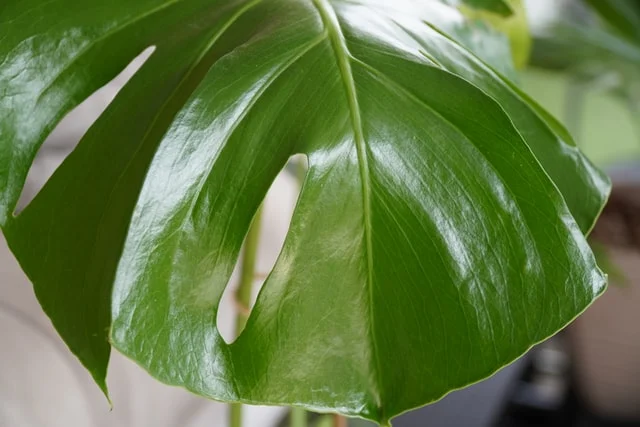Table of Contents
How to Care for Philodendron Monstera, or Swiss Cheese plant
Philodendron monstera is more commonly known by its common name Swiss Cheese plant, which is indicative of its distinctive split-leaf style.
How to Care for Philodendron monstera
Also known as windowleaf, Philodendron monstrera, isn’t actually a Philodendron at all, but actually classified as Monstera deliciosa.
The specific epithet Deliciosa, which means delicious, refers to the plants fruit. Monstera is indicative of the plant’s potential height, as they can grow up to 20-feet tall in the wild.
When grown indoors, however, they rarely surpass nine-feet tall. They are recognized by their fenestrated (hole-filled) and glossy leaves, which can be evergreen in the wild.
It also has the distinction of being the only decorative aroid that is also capable of growing fruit, though it should be noted that producing a fruit is exceedingly rare when cultivated as a houseplant.
It has a distinct woody vine, and since it often grows as an epiphyte, its stems will need support as it grows.
What does your PhilodendronMonstera require?
Light Requirements
Windowleaf require a large amount of light in order to make their leaves properly fenestrate. This means when grown as a houseplant, your Philodendron monstera will require bright light in summer and spring months, and direct sun during the winter months.
Try placing it in an east-or-south-facing sill in your home. If you do not get enough sun naturally, you can use grow lights to supplement your plants exposure. If your plant is not developing leaf perforations this can be a sign it is not receiving enough light.
Temperature Requirements
Your Monstera deliciosa can handle a wide variety of temperatures once it has been acclimated to them.
When grown indoors, your plant will do best when regular household temperatures remain above 68 degrees Fahrenheit and will continue to do better as temperatures climbs into the 80s.
It is important to note that the plant is incapable of growing if its immediate environment isn’t at least 50 degrees Fahrenheit and any prolonged exposure to temperatures approaching freezing will kill Philodendron monstera.
Soil Requirements
Philodendron monstera are fast growers that have very specific soil and potting requirements. The plants do best in a very rich soil mix that is very well drained. Ideally, this means a loosely combined mixture, comprised of equal parts potting soil and compost.
Be sure to leave ample room in your container, as this encourages faster leaf growth. The leaves and stems will need a support as they grow, so place a climbing plant pole strategically, otherwise the stems will break under the weight of their leaves.
The trunk should also be circled in moss or bark so that aerial roots have something to grab ahold of.
Humidity Requirements
As a houseplant your Philodendron monstera will require medium to high levels of humidity. This can be accomplished by misting your plant semi-frequently, placing it in a naturally humid part of your house (such as a bathroom), or using a whole room humidifier.
It should be noted that plants kept in dry, arid environments will grow at a slower rate. You can tell if this is the case if the edges of your plant’s leaves begin to turn brown, this means it is not in humid enough conditions.
How to Water
Watering should be done thoroughly, and the soil should be allowed to dry completely in between sessions. Overall frequency will depend on the size of your plant and its container.
During the spring and summer growing months watering should be done approximately once or twice every two weeks. If you notice your plant’s stems drooping, water more frequently.
If you notice that the leaves begin to “sweat,” or produce moisture, this means that the plants roots are too wet, reduce watering to prevent root rot or other issues.
Be sure to water the moss in your container so that the air roots can also get some. In the winter months cut back watering to bi-weekly.
How to Fertilize
Use a regular houseplant fertilizer and give your plant feedings every two weeks from spring to fall. When fertilizing be sure not get any on the moss, as some fertilizer can be damaging to it. There is no need to feed your plant in the winter.
Extra tips for Philodendron monstera
Eating the fruit
The fruit of the Monstera delicioso is said to taste like a mix between a pineapple, mango and banana. Every part of the plant, besides the fruit, contains oxalic acid, which is poisonous.
So, never eat anything but the plants fruit. It is also important to wait for your fruit to fully ripen, which takes about a year.
This is because eating a young fruit, with its covering still attached, will exposure the eater to painful throat irritation due to calcium oxalate crystals in the rind.
The fruit of Monstera delicioso ripens from the bottom up. You will know when your fruit is ripe when the hexagonal scales begin to dry out and fall off.
A mature fruit resembles a green corncob and will swell to around nine inches and produces an off-white, pulpy flesh. The core is inedible.
Pruning
As part of regular pruning care, it will be important to repot your plant frequently. This is because Monstera delicioso has large root systems to enable its rapid growth. The only pruning that is necessary is whatever you do to shape your plants contours.
For example, if your plant’s stems are growing too wide or tall, simply cut them back. Your Monstera delicioso will grow back quickly, so drastic cuts can be made with little fear of lasting damage.
Propagation
Propagating your Monstera delicioso can be achieved in one of two ways. The first is to take a cutting from the stem of your mature specimen and placing it in a clean potting medium to take root. The other manner that is more unique is air layering to propagate.
Air layering is means of propagating from a still attached stem. This is accomplished nicking a young, straight stem, wrapping the cut tightly in moss and waiting for an off shoot to appear. This can take up to a year to happen, in this time be sure to keep the moss moist.
Photo by Amy Photo by Karolina Kołodziejczak on Unsplash


